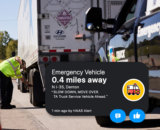Welcome to the newest post in our blog series, Compliance Corner. We frequently provide member-only regulatory toolkits on key regulatory truckstop and travel plaza issues on NATSO’s website. Perodically, we feature a snapshot of the full toolkit here on the blog.
Foodservice is an integral component of truckstop and travel plaza operations, and NATSO members offer a wide variety of food options, ranging from sit-down and quick-service restaurants to grab-and-go options within a convenience store.
Beginning in May 2017, chain restaurants and “similar retail food establishments,” including many convenience stores operated by truckstop owners and operators, will be required to post calories for prepared food items they sell.
The menu labeling rule applies to any retail establishment with 20 or more locations, including franchises, operating under the same name, offering for sale substantially the same menu items, that sells food that is intended for consumption soon after being purchased. This includes food sold at a restaurant, as well as hot and prepared food sold at convenience stores.
It is particularly important for NATSO members to understand that the menu labeling rule applies to businesses that are part of a chain of 20 or more locations regardless of who owns the locations. The owner of a single franchise business is subject to the rule if that franchise has 20 or more locations that are doing business under the same franchise name. For example, the operator of a single Subway location will be subject to the rule because there are more than 20 Subway locations.
To comply with the regulations, businesses covered by the rule must post calories on menus or menu boards and potentially on signage next to self-service items and foods on display. Locations also will be required to provide additional written nutrition information to consumers upon request.
The calorie count listed should include the number of calories that the item has when it is prepared in the usual manner by the establishment, and the number of calories must be listed adjacent to the name or price of the associated menu item in a type size no smaller than the type size of the name or price of the item, whichever is smaller.
The term “Calories” or “Cal” must appear either as a heading above the column listing the number of calories or adjacent to the calorie listing for each item. The rules also have color requirements designed to require the calorie declaration to be as conspicuous as the name and price of the item.
Calories must be declared to the nearest five-calorie increment up to and including 50 calories, and to the nearest 10-calorie increment above 50 calories. Food items with fewer than five calories may be expressed as zero.
There are a few exceptions to the rule. Temporary menu items that are offered for fewer than 60 total days per year are not subject to the menu labeling rule. Neither is food that is part of a market test—food that is offered for less than 90 consecutive days in order to test consumer acceptance of the product.
To help NATSO members prepare for the upcoming compliance date, NATSO has created a comprehensive menu labeling guide that offers additional details on how the menu labeling rule applies to travel plazas, including:
- which individual ultimately is responsible for complying with the menu labeling rule;
- how to declare calorie information for combination meals; and
- how an operator can determine if something qualifies as a “menu or menu board” as opposed to an advertisement or poster.
// NATSO Members: Get the Full Regulatory Toolkit. NATSO has prepared a document outlining these issues and more. The full document is available to NATSO members here.
(The regulatory toolkit is available for NATSO Members only. If you need any assistance logging in, please contact NATSO Member Services at (703) 549-2100 between the hours of 9:00 a.m. and 5:00 p.m. EST, Monday through Friday, or e-mail us at membership@natso.com.)
Subscribe to Updates
NATSO provides a breadth of information created to strengthen travel plazas’ ability to meet the needs of the travelling public in an age of disruption. This includes knowledge filled blog posts, articles and publications. If you would like to receive a digest of blog post and articles directly in your inbox, please provide your name, email and the frequency of the updates you want to receive the email digest.



